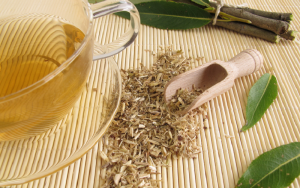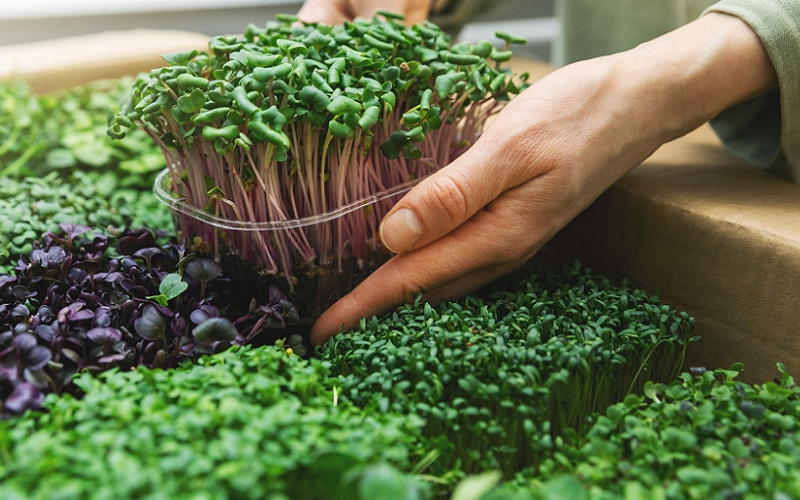
Microgreens are tiny plants that pack a big nutritional punch. Though small in size, these plants are far from insignificant when it comes to their health benefits.
Microgreens are tiny plants that pack a big nutritional punch. Though small in size, these plants are far from insignificant when it comes to their health benefits. Microgreens have been gaining increasing attention from chefs, health enthusiasts, and environmentalists alike, making them a fascinating topic of exploration.
Contents
Introduction to Microgreens: The Tiny Powerhouses
In recent years, there’s been an increasing buzz around microgreens. These tiny plants, though small in stature, are enormous in flavor and nutritional content. They are becoming increasingly popular in both culinary and nutritional circles, praised for their distinct taste and dense nutrient profile. But what exactly are microgreens, and why should they matter to you?
Definition and Overview of Microgreens
Microgreens are the seedlings of vegetables and herbs. Once the seed of an herb or vegetable begins to grow, it becomes a sprout. After sprouting, the young plant becomes a microgreen. They are generally harvested just after the first “true” leaves have developed, typically between 1-3 weeks after germination. Their size ranges from 1 to 3 inches, including the stem and leaves.
Even though they are tiny, they have a strong and often concentrated flavor. Microgreens can come from a variety of plants including radish, broccoli, beet, sunflower, and peas. Each variety has a unique taste, offering an exciting addition to the palette and plate alike.
Brief History of Microgreens in Food Culture
Microgreens were first used in cuisine in the 1980s in San Francisco. Chefs used them to enhance the flavor and visual appeal of their dishes. In the 1990s, their popularity began to spread to other parts of the United States. Today, microgreens are a staple in many restaurants and homes across the country, and indeed, around the world.
Though they may have started out as a culinary trend, their staying power is undoubtedly due to their intense flavors and nutritional potency. Increasingly, they are not only appreciated by chefs for their aesthetic and flavor-enhancing properties, but also by nutritionists for their health benefits [1].
Importance of Microgreens in Modern Diet
Microgreens are more than just a culinary trend. They are a nutritional powerhouse that can enrich our modern diets in significant ways. Despite their size, they are packed with vitamins, minerals, and beneficial plant compounds.
In a world where many people struggle to meet their daily recommended intake of vegetables, microgreens offer a concentrated source of nutrients. They allow us to get our daily dose of vitamins and minerals without having to consume large volumes of food. Because they are so flavorful, they also make it more enjoyable to eat healthily.
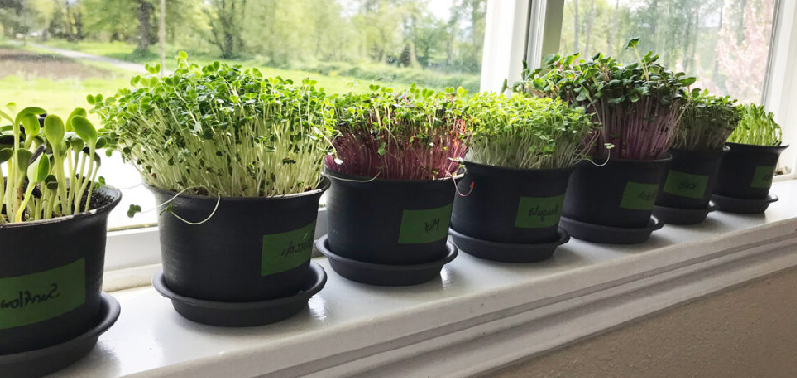
Understanding the Nutritional Benefits of Microgreens
Microgreens are not just a pretty garnish on your plate. They come with an array of nutritional benefits that make them a potent addition to your diet. Despite their minuscule size, they are packed with a concentrated dose of vitamins, minerals, and phytochemicals, often surpassing their mature counterparts.
Nutrient Density of Microgreens
The term “nutrient density” refers to the concentration of nutrients per unit of food. Microgreens excel in this regard, often containing higher nutrient levels than mature leaves of the same plant.
Vitamins and Minerals Present
Microgreens are packed with a variety of vitamins and minerals. While the exact nutritional content can vary between types, most are high in Vitamins C, E, K, and beta-carotene. Vitamins are essential for our bodies to function correctly, aiding in various bodily functions including the immune system, blood clotting, and maintaining good vision [2].
Microgreens are also a good source of essential minerals like potassium, iron, zinc, magnesium, and copper. These minerals support numerous functions in the body, including bone health, heart health, and maintaining optimal nerve function.
Comparison to Full-Grown Vegetables
A fascinating aspect of microgreens is that they often contain higher concentrations of nutrients compared to their mature counterparts. This is because the plant concentrates its energy into producing these nutrients in the early stages of growth, making microgreens a densely packed source of nutrients [3].
For example, research has shown that red cabbage microgreens have six times more Vitamin C and 69 times more Vitamin K than mature red cabbage. Similarly, garnet amaranth microgreens were found to have 8 times more Vitamin E than their fully grown counterparts. This gives us an idea of just how nutrient-rich these tiny plants can be.
Antioxidants and Phytochemicals in Microgreens
In addition to vitamins and minerals, microgreens are rich in antioxidants and phytochemicals. These compounds help protect your body’s cells from damage by neutralizing harmful free radicals.
This protective function is crucial in preventing chronic diseases like heart disease, diabetes, and certain types of cancer. The high concentration of antioxidants in microgreens makes them an excellent addition to your diet if you’re looking to boost your overall health and wellness [4].
Specific Benefits of Popular Microgreen Varieties
Different varieties of microgreens offer unique benefits, contributing to their overall nutritional diversity.
Broccoli Microgreens
Broccoli microgreens are a standout for their high content of sulforaphane, a compound known for its potential cancer-fighting properties.
Radish Microgreens
Radish microgreens are high in Vitamins A, B, C, E, and K, and are also an excellent source of calcium, iron, magnesium, phosphorus, potassium, and zinc.
Sunflower Microgreens
Sunflower microgreens are high in protein and a healthy source of beneficial fats. They also provide a good amount of zinc, a mineral essential for immune health.
Pea Microgreens
Pea microgreens are rich in folate and Vitamin A, which are essential for heart health and good vision, respectively.
Wheatgrass
While technically not a microgreen but a grass, wheatgrass is often grown and harvested like one. It’s known for its high chlorophyll content and detoxifying properties.
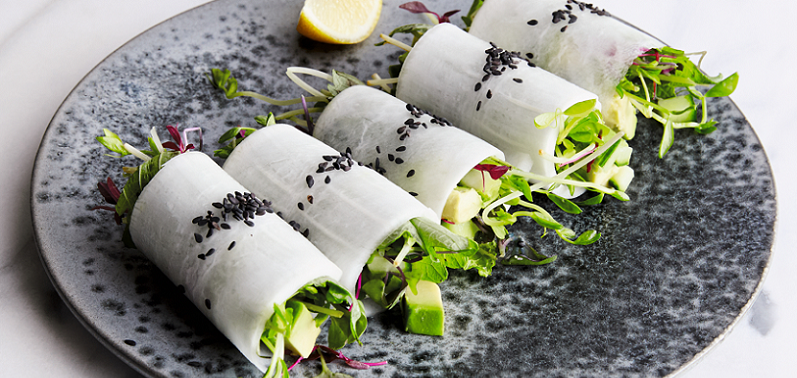
Incorporating Microgreens into Your Diet
Now that we’ve covered the impressive nutritional profile of microgreens, you might be wondering: how can I incorporate these tiny powerhouses into my diet? The great news is that their small size and intense flavor make them a versatile addition to a variety of meals. From breakfast to dinner, and even in snacks and drinks, there’s room for microgreens in every part of your day.
Incorporating Microgreens into Meals
Microgreens can be used in numerous ways in the kitchen. Due to their often potent flavor and visual appeal, they can add both taste and aesthetics to your meals.
Breakfast Ideas
Start your day on a nutritious note by adding microgreens to your breakfast. They make an excellent topping for avocado toast or scrambled eggs. You can also blend them into your morning smoothie or juice for an added nutrient boost. For a creative twist, try making a microgreen pesto and spread it on a bagel for a flavorful and healthful breakfast.
Lunch and Dinner Ideas
Microgreens can be used in a variety of lunch and dinner dishes. Toss them into your salad or use them as a garnish for your soup. They can also be used to enhance the flavor and nutritional profile of sandwiches, wraps, and tacos. Try sprinkling microgreens over pasta or stir them into risotto just before serving. They are also a beautiful and tasty addition to a variety of seafood, poultry, and meat dishes.
Snacks and Smoothies
For snacks, microgreens can be used in various ways. You can sprinkle them over hummus or another dip, add them to wraps or sandwiches, or use them to top off a piece of whole-grain toast. They can also be incorporated into your favorite smoothies for an extra nutrient boost. Not only will this enhance the flavor, but it also increases the nutritional value of your snack or drink.
Creative Recipes to Try
To help you get started with using microgreens in your cooking, here are a few creative recipes:
- Microgreen Salad with Lemon Vinaigrette: A vibrant salad featuring a variety of microgreens, cucumber, cherry tomatoes, and a zesty lemon vinaigrette.
- Microgreen Pizza: A delicious pizza featuring a variety of microgreens as a topping, combined with goat cheese, roasted garlic, and cherry tomatoes.
- Avocado and Microgreen Toast: This simple yet delightful recipe takes the avocado toast to another level by adding a layer of fresh microgreens.
- Microgreen Pesto Pasta: A refreshing pasta dish that uses homemade microgreen pesto made from basil microgreens, garlic, pine nuts, Parmesan cheese, and olive oil.
- Microgreen Smoothie: A nutrient-packed smoothie featuring spinach microgreens, banana, blueberries, and almond milk.
Remember, the key to enjoying microgreens is experimenting and trying different varieties to discover what you like best.
Tips for Buying Microgreens at the Grocery Store
When purchasing microgreens, look for fresh, vibrant greens that don’t show any signs of wilting. They should have a pleasant aroma and a clean, fresh taste. Make sure to check the packaging date and try to choose the freshest pack. Store them in the fridge, ideally in the crisper drawer where they can stay cool and humid. Try to use them within a week to enjoy their optimal flavor and nutrition.
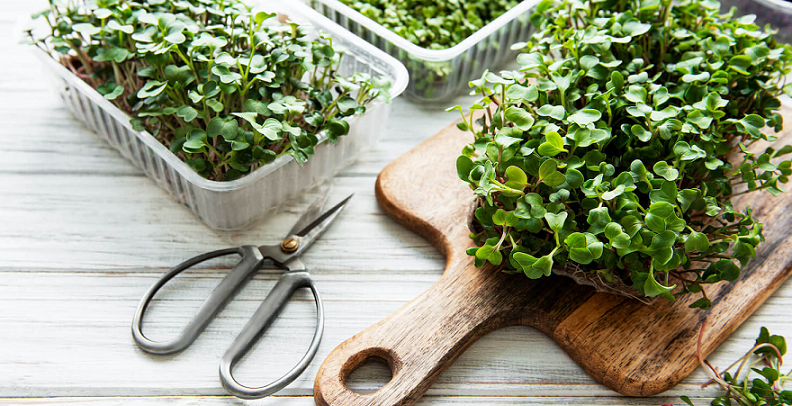
Growing Your Own Microgreens at Home
Perhaps one of the most exciting things about microgreens is that they’re relatively easy to grow at home, requiring minimal space and equipment. Not only is it a rewarding hobby, but it’s also a great way to have a fresh and convenient supply of these nutritious greens at your fingertips.
Benefits of Growing Microgreens at Home
Growing your own microgreens comes with a host of benefits. Firstly, it allows you to have the freshest possible greens, ensuring optimal taste and nutritional value. It’s also cost-effective, particularly if you consume microgreens regularly. Moreover, it provides the opportunity to experiment with different varieties that may not be readily available in your local supermarket. Lastly, growing microgreens is a great introduction to gardening, requiring minimal space and offering quick results [5].
Step-by-Step Guide to Starting Your Own Microgreen Garden
Growing microgreens is a simple and rewarding process. Here’s a basic step-by-step guide to get you started:
- Select Your Seeds: Start by choosing the seeds of the plants you’d like to grow. Some popular options include radish, broccoli, beet, and sunflower.
- Prepare Your Container: Almost any shallow container with drainage holes will work for growing microgreens. Fill it with a layer of potting soil or seed starter, leaving about half an inch of space at the top.
- Sow Your Seeds: Sprinkle your seeds evenly across the surface of the soil. For most microgreens, you don’t need to cover the seeds with soil.
- Water and Cover: Mist your seeds gently with water using a spray bottle, then cover your container with a lid or another tray to create a mini-greenhouse effect.
- Wait and Water: In a few days, your seeds will start to sprout. Continue to mist them daily, ensuring the soil stays moist but not waterlogged.
- Harvest Your Microgreens: Once your microgreens have developed their first set of true leaves, typically in 1-3 weeks, they’re ready to harvest. Simply cut them above the soil line with a pair of clean scissors.
Essential Tips for Successful Growth
To maximize your success when growing microgreens, here are some tips to keep in mind:
- Light: While microgreens can germinate in low light conditions, they’ll need plenty of light to grow after sprouting. A sunny windowsill or grow lights can provide the necessary light.
- Temperature: Microgreens prefer a comfortable room temperature, around 65-75°F (18-24°C).
- Watering: Overwatering can lead to problems like mold and damping off. Using a spray bottle to mist your plants can help prevent overwatering.
- Soil: Using a fine seed-starting mix can enhance your success. The soil should be rich but also well-draining.
- Seed Quality: Be sure to source your seeds from a reputable supplier, and opt for seeds specifically intended for sprouting and growing microgreens.
Troubleshooting Common Microgreen Growing Problems
Like any gardening venture, growing microgreens can come with a few challenges. However, most issues can be easily resolved:
- If your microgreens are not germinating well, the issue could be old seeds, improper watering, or insufficient temperature.
- If your microgreens are growing slowly or look pale, they might need more light. Consider placing them in a sunnier location or using grow lights.
- If you notice mold on your microgreens, it could be due to overwatering, poor air circulation, or high humidity. Water less frequently, increase ventilation, and consider using a fan to improve air circulation.
- If your microgreens fall over and don’t recover, they might have ‘damping off,’ a fungal disease often caused by overwatering. Try watering less, improving air circulation, and using clean containers and fresh soil.
Growing microgreens at home can be a fun, rewarding, and ultimately tasty endeavor. With a bit of practice, you can enjoy a constant supply of fresh, nutritious microgreens straight from your windowsill to your plate.
The Environmental Impact of Microgreens
Microgreens not only bring significant health benefits but also have a relatively small environmental footprint, particularly when grown at home or locally. They require little space, minimal water, and grow quickly, making them an eco-friendly choice.
Sustainability of Microgreens
Microgreens offer several sustainability advantages that make them an eco-friendly choice in our diet [6].
Efficient Use of Space
Microgreens are perfect for urban farming practices because they require very little space. They can be grown vertically, indoors, in a small patch of garden, or even on a sunny windowsill. This makes them ideal for high-yield urban farming and community garden projects, which can bring fresh produce into the heart of cities and reduce the need for long-distance transportation.
Minimal Water Requirements
Microgreens are water-efficient crops. They require much less water per unit of growth than traditional crops due to their small size and short growing cycle. This makes them a more sustainable choice in areas where water scarcity is a concern.
Quick Growing Cycle
The quick growing cycle of microgreens (1-3 weeks) contributes to their sustainability. Because they grow so rapidly, more crops can be grown in the same area over a given period compared to conventional vegetables. This rapid turnover can provide a sustainable and continuous source of fresh produce.
Reducing Food Miles with Microgreens
“Food miles” refer to the distance food travels from the place it’s grown to the place it’s consumed. The concept highlights the environmental impact of transporting food over long distances.
Because microgreens can be grown virtually anywhere – from urban indoor farms to your own kitchen countertop – they can significantly reduce food miles. By growing your own microgreens or sourcing them locally, you’re cutting down on transportation emissions associated with getting your food from farm to table.
Role in Waste Reduction
Microgreens can also play a role in reducing waste in our food system.
Edible Whole Plant
With microgreens, virtually the entire plant is edible, which minimizes waste. There’s no need to discard stems or leaves as you might with mature vegetables.
Composting Microgreen Soil
After harvesting your microgreens, the remaining soil and root matter can be composted and returned to the earth, contributing to a closed-loop system that minimizes waste.
References
[1] The Beginner’s Nutritional Guide to Incredible Microgreens
[2] Health benefits of microgreens
[3] What Are Microgreens? Everything You Need to Know About the Nutritious Garnish
[4] Microgreens—A Comprehensive Review of Bioactive Molecules and Health Benefits
[5] Nutritional quality and health benefits of microgreens, a crop of modern agriculture
[6] Is There Any Benefit To Microgreens Beyond Looking Adorbs?





